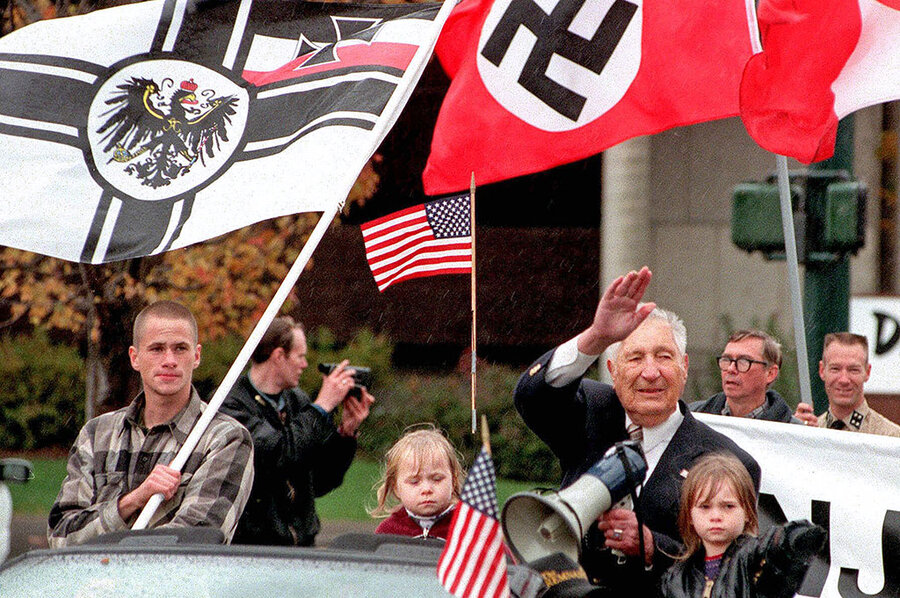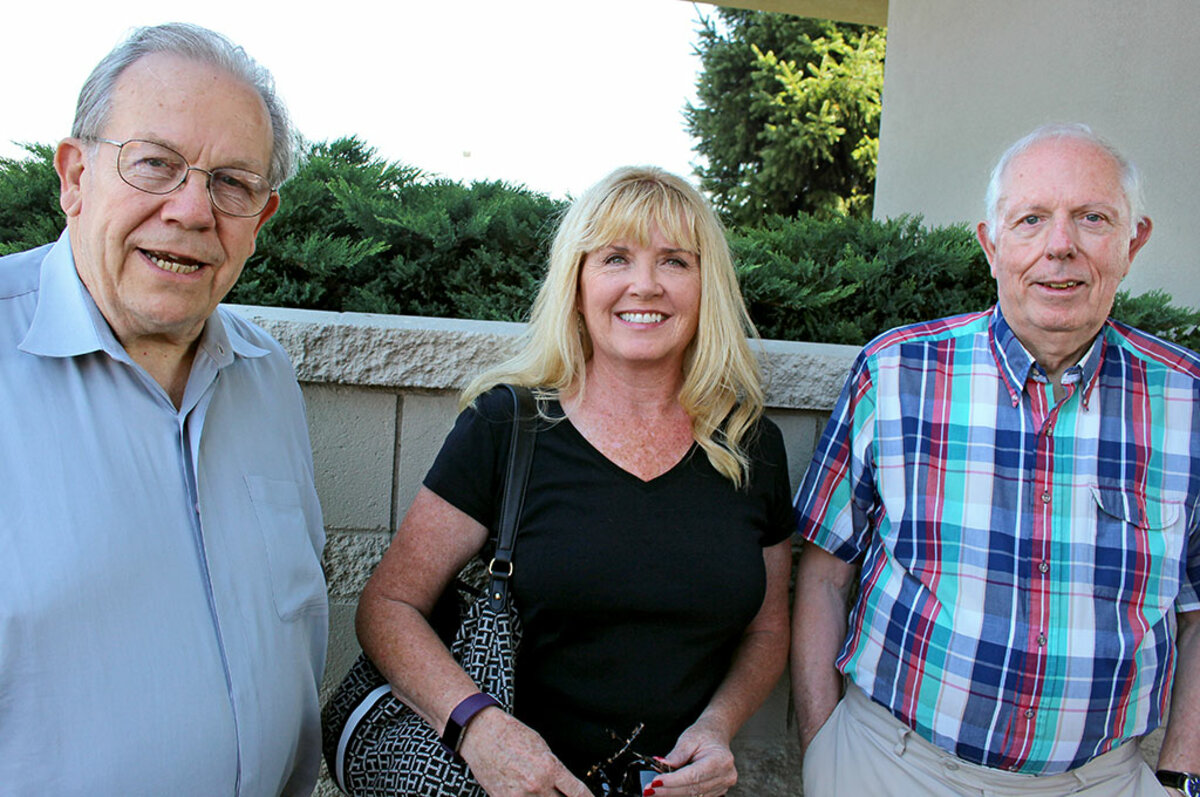The Idaho town that stared down hate – and won
Loading...
| Coeur d’Alene, Idaho
The “church” dripped with Nazi flags, swastikas, and racist war cries. Adolf Hitler stared from a bust. Outside, a guard tower watched over the compound set on a path marked “whites only” in the lush hills of northern Idaho.
From his self-proclaimed Aryan Nations church, a retired engineer named Richard Butler preached hate to his followers, and served it upon the community here. It was the same toxic ideology that brought violence to Charlottesville, Va., and for years it poisoned this town. Coeur d’Alene became code for white supremacists.
But what happened here offers an antidote of hope. The community came together, rejecting the vision of Mr. Butler’s small band, and organizing a tenacious effort to drive them out without the dangerous confrontation that produced one death and dozens of injuries in Virginia. It took more than two decades, but it worked.
“We won,” says Norman Gissel, a long veteran of the struggle, and a member of the Kootenai County Task Force on Human Relations. Mr. Gissel and others involved in that campaign are loathe to offer their strategy as a sure solution for other cities. But they say their approach might be one guide.
“One of our rules from the very beginning was that we would never go to anything the Nazis did,” Tony Stewart, another founder of the task force, says. But that did not mean ignoring them. “We decided we would never remain silent, but when they did activities we would do a counter-program at some other location.”
Hatching the strategy
Mr. Stewart recalls the night that strategy was hatched. Butler had come to this postcard-pretty town near the Canadian border in 1974, bought 20 acres 11 miles out of town, and opened his doors to the Ku Klux Klan and neo-Nazis who rejected the “mud races” of diversity. He gave Sunday sermons promoting a “White People’s Republic” in the Northwest.
Most people here ignored them. “In Idaho, we don’t tell you a lot about what you should do. We don’t mess with people,” Woody McEvers, now president of the city council, said at his restaurant, the Rustler’s Roost, where Butler and his followers often came on Sunday afternoons.
But then a Jewish restaurant was painted with ugly graffiti. A 9-year-old black girl was harassed. The group started having an annual “world congress” on its property, with rallies and marches in 1985 and 1986. A bomb blew in the back door of a Catholic priest who had condemned their march, while he sat in his living room.
“People did not react until there were victims,” says Stewart.
Even before that, Stewart, Gissel, and others decided the town should no longer be complacent. A small group of 10 gathered on cold February night in 1981 in the basement of a church to form the Kootenai County Task Force on Human Relations. Others were there: “There were six neo-Nazis trying to intimidate us,” Stewart recalls. “They came and just walked in the back. They were walking back and forth. They were trying to frighten us or get us not to do anything.”
The organizers ignored them. They embraced some old-fashioned phrases – freedom, equality, and justice – and decided on a way to challenge the Aryan Nations. When the Aryan Nations marched, the group sponsored counter protests as far away as Spokane to draw the crowds down. For one event, Stewart enlisted local businesses and individuals to pledge money to human rights groups for every minute of a planned Aryan Nations march, and then publicly urged Butler to march slowly to raise more money for his opponents.
“They marched for 27 minutes and we got $34,000,” Stewart chuckled.
But others did directly confront the Aryan Nations marchers, and the Coeur d’Alene police worked hard to try to keep the groups separate.
“I was a young patrolman at the time,” says Christie Wood. “It was stressful, difficult. We had a role to keep peace, but part of that role was marching alongside these white supremacists who you didn’t even want to have to look at.”
There were arrests on both sides, but no serious injuries. “At any moment it could have gotten out of hand like it did in Charlottesville,” Ms. Wood says.
Violence brought the downfall
And it was not all political theater. A splinter group from Aryan Nations, called the Order, killed a Jewish Denver radio talk host in 1984, and robbed several banks and armored cars before its leader was killed in a shootout with federal agents in Whidbey Island, Wash. In 1986, three bombs went off in Coeur d’Alene, remarkably causing no injuries. When this reporter visited Butler’s compound a week after the bombings, the mother of one of Butler’s followers argued that her son had acted righteously in gunning down a Missouri state trooper the previous year with a silencer-equipped automatic pistol. He is serving a term of life without parole for that murder.
It was the group’s violence that finally brought it down. In 1998, an American Indian woman and her son were driving by the compound when her car backfired. The compound’s guards, imagining gunshots, chased her, firing into the vehicle and forcing it off the road, and terrorized the pair at gunpoint. The Southern Poverty Law Center pounced on the incident, bringing lawsuits on behalf of the victims.
They won a $6.3 million judgment in 2000 against Butler, and two of his bodyguards served prison time for assault.
Gissel, an attorney who brought nationally prominent lawyers into the case, said the jury voted the large award to uphold the culture of Kootenai county.
“We won that case ... because the jury was on our side for 20 years,” he says. “When the police and prosecutors do their jobs well and aggressively, the jury will do theirs.”
Butler’s compound was seized in the judgment, used as a training exercise by the fire department and burned to the ground. “We didn’t want anything left to show they were ever here,” Stewart says. They cut down two trees that had swastikas carved on them, and stipulated that the ground lay fallow for 20 years.
“There was so much hate here. It needed to rest,” Stewart says.
The property is now an unmarked stand of pines and open field next to an Alpaca farm.
The challenge: to keep a sense of community
Butler died in his 80s in 2004. Various adherents claimed his mantle, none to much consequence. But the task force members say their work continues. Philanthropist Greg Carr donated $1 million to create the Human Rights Education Institute, which carries out education, and the task force consults with communities under similar threat. Successive administrations in the town and county have continued to support the work.
“We have had to work hard to keep our sense of community. It’s not always been easy,” says Sandi Bloem, who was mayor for 12 years. The task force has put on a tolerance program for 32,000 fifth graders. The schools have adopted an anti-bullying campaign. The city went through a bruising debate and ultimately adopted an ordinance guaranteeing equal rights for gay and lesbians, an unusual step in conservative Idaho.
But the picture of success is not unmarred. In recent years, racist leaflets have been scattered about town. A few white supremacists picketed a human rights gala ball. Food trucks owned by Hispanics were vandalized and the owners harassed. (The task force urged everyone to eat lunch from the trucks. “The police officers got tired of eating tacos every day,” says Stewart, laughing.)
And while the town has doubled in size to 44,000 people, gradually changing from a blue-collar town to one filled with hip eateries, a medical center, and street corners sprouting public art, it still attracts people drawn to a community of mostly white population, says former Mayor Bloem.
“Those people still exist. There are still undercurrents,” agrees Lita Burns, a director of the Human Rights Education Institute. Of Mexican ancestry, she came 16 years ago, and was startled when her 8-year-old daughter asked why people stared at them. Coeur d’Alene has changed for the better, she says, but “we don’t want to forget that history. We have to learn from the history.”
The violence in Charlottesville has revived uncomfortable debate in Coeur d’Alene. The daily newspaper, on a recent day, had an editorial saying “Love is the answer,” next to letters to the editor making a thinly veiled analogy of newcomers to “nasty little beasts” and another blaming the “alt-left communists” who confronted the marchers in Charlottesville.
“There’s no community devoid of hate. No such community exists,” says Stewart. “What we could say to any community in America is, never allow the perpetrators of hate come into your community and change you. Never let them be in charge. Never stay silent.”






